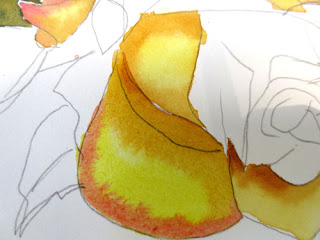TO PAINT THIS SEA TURTLE
I got the reference photo from UNSPLASH from the pixabay
web site, which offers public domain photos. If anybody has other
public domain references that they like, please let me know.
First, sketch the turtle on cold press paper and miskit out the
white lines on the shell an flippers. What you see in gray
is where I put miskit. In this example, I applied miskit with a color
shaper, made for pastels. You can also apply with a soapy brush. I have since
discovered that an inexpensive Polar Flo by Creative Mark works very well also.
Do not mask out the underbelly of the shell.
I wanted to play warm against cool colors. I wet the shell completely, and starting at the bottom
rim, I painted in with quinacridone gold, quin burnt orange (or any brown/orange like burnt sienna),
and magenta. As it dried, but had not lost its shine, I added pthalo blue around cracks in the shell where it would curve under a bit. You can salt a bit for texture, or spritz speckles in it as it dries.
While the top shell is drying, softly paint a warm neutral color for the spots on the
underbelly. Avoid hard edges here. While that is drying, begin the head area. The colors I used
were: Pthalo blue, quin magenta, and some quin gold. I was aiming for a bright, multi-colored
cool for most of the head. Avoid painting the eye yet.
Finish all the flippers with the same colors you used in the head. You want strong color
on the leading edges of the flippers. (Miskit is still on everything.) Notice that I salted the shell
in the first step, and the colors are faded on the top shell.
Using the same colors as before, I glazed over the top shell until I was happy with
the amount of glow. For the underbelly, under the mouth, and underpart of the far
right flipper, I glazed over with cobalt teal blue. I used this instead of a watered down
pthalo (which is OK to use) because it doesn't get dark, and it lifts better than pthalo
if I want to make it softened later.
Remove all the miskit. Whoa! Bright white! Paint in the eye using dark blue
and purple, leaving a spot of white.
Decide on a few bright whites you want to keep, and glaze over the head,shell, and
flippers with water, letting the paint move lightly over the whites to dull them down
a bit. Strenthen any darks you see under the shell (near the back flipper) etc.
You can paint thin light lines on the far right flipper, just faintly.

This is one way to create a watery look. In class we will investigate several ways.
I covered the entire turtle with contact paper (clear), and carefully cut around the
shape of the turtle with an exacto knife. Then I pulled away the background, leaving
the contact paper on the turtle.
IF YOU DON'T WANT THE PAINT TO BLEED over the top shell, apply a thin line of miskit on
the paper above the shell.
I made puddles of several blues,( including cobalt, pthalo, and cobalt teal) on my palette, with a bit of
green gold. I wet the background (trying to be sure my contact paper was secure)and then laid in
washes of the blues. While it was still shiny, I wrinkled some plastic wrap and laid it on top of the wet paint. Then I watched it dry.
If you think it is drying too hard edged, remove the plastic and sprits a bit in places it is getting
too hard edged.
I MADE A MISTAKE ON THIS ONE.
Which is nothing unusual. I did not miskit the top, and some of the blue from the background seeped under the contact paper. It created a blue-ish backrun on the top of the shell, just where I wanted a
nice light glow. I just waited for the entire painting to dry, lifted a bit, dried it, and painted some quin gold over it.
















































